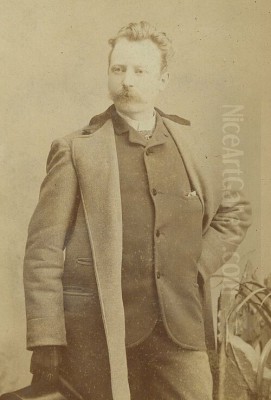
Antonio Nicolo Gasparo Jacobsen stands as one of the most prolific and recognizable marine artists in American history. Active during a transformative period in maritime technology, Jacobsen dedicated his career to meticulously documenting the vessels that plied the waters, particularly those entering and leaving the bustling port of New York. His vast output, estimated at over 6,000 paintings, earned him the affectionate title "the Audubon of Steam Vessels," a testament to his comprehensive visual catalog of ships ranging from elegant clipper ships to powerful ocean liners. Born in Denmark but finding his true calling in the United States, Jacobsen's work provides an invaluable window into the maritime world of the late 19th and early 20th centuries.
Early Life and Artistic Awakening in Copenhagen
Antonio Jacobsen was born in Copenhagen, Denmark, on November 2, 1850. His early life was steeped in craftsmanship and artistry, though initially directed towards music. His father, Thomas Jacobsen, was a respected violin maker in Copenhagen. Family lore, and indeed Antonio's own middle names (Nicolo Gasparo), suggest a connection or deep admiration for the legendary Italian violin makers Nicolò Amati and Gasparo da Salò, though direct tutelage under masters like Stradivari, as sometimes mentioned, is more likely an embellishment reflecting the family's aspirations and respect for the craft. Antonio himself showed promise as a musician.
Despite this musical inclination, the visual arts ultimately captured Jacobsen's passion. He pursued formal art training at the prestigious Royal Academy of Design in Copenhagen. However, his path took a decisive turn away from both music and his homeland. At the age of 22, around 1872-1873, Jacobsen made the life-altering decision to emigrate from Denmark. The exact reasons remain somewhat unclear, often attributed to escaping service in the Prusso-Danish War or simply seeking greater opportunities abroad, a common motivation for many Europeans during that era.
Immigration and the Port of New York
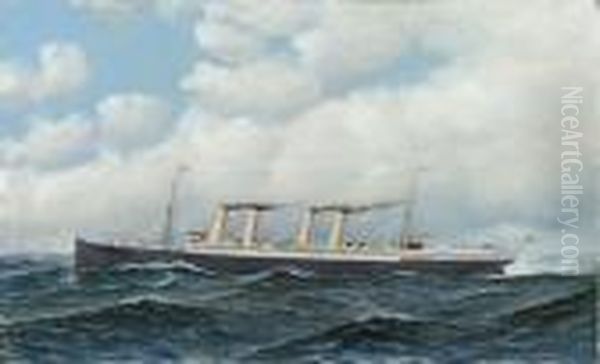
In 1873, Antonio Jacobsen arrived in the United States, choosing to settle across the Hudson River from the vibrant maritime hub of New York City. He established his home and, eventually, his studio in West Hoboken, New Jersey (an area that is now part of Union City). This location provided him with an unparalleled vantage point. The Hudson River and New York Harbor teemed with maritime traffic, showcasing the dramatic transition from sail to steam power that characterized the era.
Jacobsen quickly immersed himself in this environment. He reportedly began his American artistic career by sketching and painting ships directly from observation points like Battery Park at the southern tip of Manhattan. This direct engagement with his subject matter became a hallmark of his approach. He wasn't merely painting generic ships; he was creating portraits of specific vessels, capturing their individual characteristics and identities.
His business acumen developed alongside his artistic skill. He established a studio, for a time located at 257 Eighth Avenue in Manhattan, and actively sought commissions. He would approach ship captains, owners, shipping line executives, and even crew members, often showing examples of his work and leaving contact information. This direct marketing, combined with the accuracy and appeal of his paintings, quickly built his reputation within the maritime community.
Artistic Style: Realism and Precision
Jacobsen's artistic style is firmly rooted in Realism. His primary goal was to create accurate and detailed portraits of ships. Clients commissioned his work not just for aesthetic pleasure, but often as a record of their vessel, a source of pride, or even for insurance purposes. Accuracy was paramount. He became known for his meticulous attention to detail, carefully rendering the specific architecture of each ship – the lines of the hull, the arrangement of masts and rigging on sailing ships, the funnels and deck structures of steamers, the placement of lifeboats, and even the details of flags and pennants.
His compositions typically feature the vessel in profile or three-quarter view, often set against a backdrop of the sea and sky. While the ship itself was rendered with sharp precision, his treatment of the water and atmosphere could vary. He depicted ships in calm seas under clear skies, battling choppy waves under dramatic clouds, or navigating hazy conditions. His palette often included deep blues, greens, and grays for the water, sometimes employing darker, almost brown or black tones for stormy seas, contrasted with carefully observed atmospheric effects in the sky.
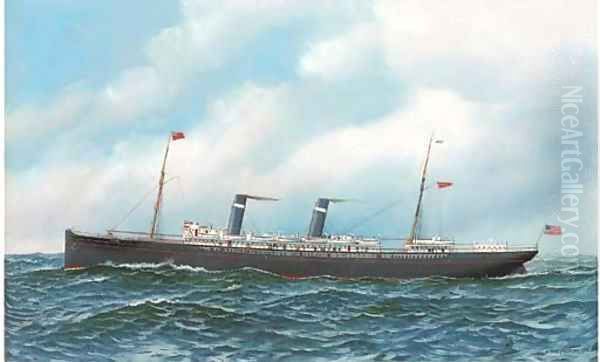
Jacobsen developed a highly efficient working method to meet the considerable demand for his paintings. While capable of fine detail, his style, particularly in later years, could sometimes appear formulaic, suggesting the use of templates or standardized approaches for certain elements like water and sky. This efficiency allowed him to produce an astonishing number of works. He often painted on academy board or canvas, typically in standard sizes that suited his clientele's needs for display in offices or homes.
The "Audubon of Steam Vessels"
The nickname "Audubon of Steam Vessels" aptly captures the comprehensive nature of Jacobsen's work. Just as John James Audubon sought to document the birds of North America, Jacobsen created an extensive visual encyclopedia of the ships of his time. His focus spanned the entire spectrum of maritime traffic: majestic clipper ships representing the final glory of the age of sail, sturdy schooners and barks involved in coastal trade, hardworking tugboats and ferries essential to harbor operations, and the increasingly dominant steamships, from early side-wheelers to the grand ocean liners that connected continents.
His output was staggering. Estimates place the number of paintings he created at over 6,000. This prolificacy was driven by constant demand. Shipping lines commissioned portraits of their entire fleets. Captains wanted paintings of the vessels under their command. Crew members and passengers sometimes sought mementos of their voyages. Jacobsen became the go-to artist for anyone seeking a faithful representation of a specific ship that sailed into or out of New York Harbor.
This dedication to documentation makes Jacobsen's oeuvre an invaluable historical resource. His paintings capture the evolution of ship design during a critical period. They record the house flags and funnel markings of numerous shipping lines, many long defunct. They provide visual evidence of the ships involved in major historical events, from transatlantic immigration to naval service. Maritime historians and museum curators rely heavily on his work for its accuracy and breadth.
A Prolific Practice and Notable Works
Jacobsen's studio was a hub of activity. Sources suggest he could complete two or three paintings in a single day, a remarkable pace that underscores his efficient technique and the steady stream of commissions. His works were typically signed "Antonio Jacobsen," often followed by the year and his West Hoboken address, further emphasizing their function as specific records.
Among his vast body of work, certain paintings stand out or are frequently reproduced. While selecting just a few is difficult, examples include:
Niagara: Depicting a prominent vessel, showcasing his ability to capture the power and grace of steamships.
DE RUYTER: Another example highlighting his skill in rendering specific ship details and sea conditions.
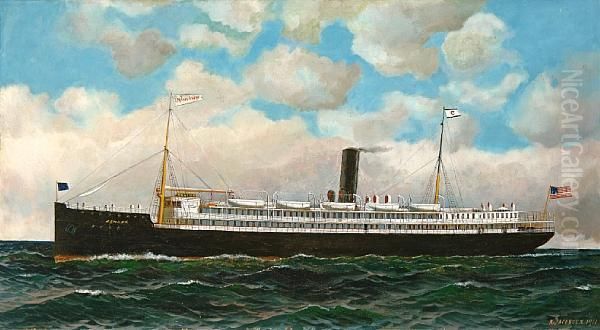
The Bark Columbia (Ships in New York Harbor) (1915): A later work showing his continued engagement with sailing vessels even as steam dominated.
The Goldfield (1911): Representing the many working vessels he documented.
City of Augusta: A detailed portrait of a coastal steamer.
Kronprinz Wilhelm: Capturing one of the famous German ocean liners.
St. Paul: Depicting a well-known American Line steamer.
Oregon: A record of another significant vessel of the era.
Mohawk: Illustrating his ability to portray ships in dynamic sea conditions.
These are but a tiny fraction of his total output. He painted famous liners like those of the Cunard Line and White Star Line, numerous vessels of the Fall River Line, naval ships, private yachts, and countless less glamorous but equally important commercial vessels. Each painting, regardless of the subject's prestige, typically received the same careful attention to accurate portrayal.
The Hoboken Context and Contemporaries
While Jacobsen was exceptionally prolific, he was not working in isolation. He is often considered a leading figure of the "Hoboken School" of marine painters. This wasn't a formal institution but rather a loose designation for artists working in and around the New York Harbor area, particularly Hoboken, who specialized in ship portraits during the late 19th and early 20th centuries. These artists often shared clientele and a similar focus on accurate representation.
One of Jacobsen's most direct contemporaries and sometimes considered a rival within the Hoboken group was Fred Pansing (1844-1912). Pansing, also an immigrant (from Germany), produced many ship portraits similar in style and purpose to Jacobsen's, and also worked as a lithographer for firms like Currier & Ives.
Other notable marine artists active during Jacobsen's time, or whose careers overlapped or influenced the genre, include:
James E. Buttersworth (1817-1894): An English-American painter considered one of the foremost American marine artists of the 19th century. Though his peak was slightly earlier than Jacobsen's, their careers overlapped, and Buttersworth's dramatic yachting scenes and ship portraits set a high standard.
James Gale Tyler (1855-1931): A prolific American marine painter known for his depictions of yachts, naval scenes, and clipper ships, often with a more romantic or dramatic flair than Jacobsen.
Elisha Taylor Baker (1827-1890): Known for his precise, almost naive style ship portraits, often depicting vessels on the Long Island Sound.
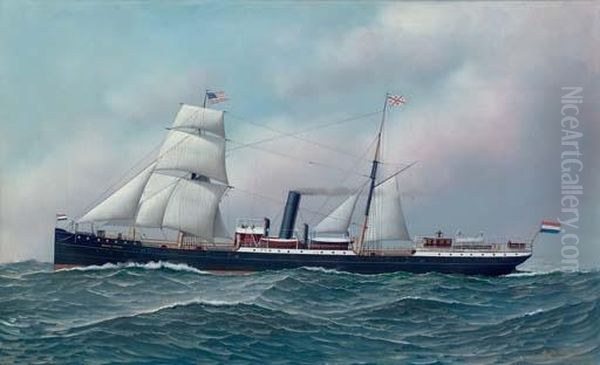
Charles Robert Patterson (1878-1958): Born at sea, he brought firsthand maritime experience to his paintings, particularly known for his depictions of sailing ships in dramatic open ocean settings. His career extended well beyond Jacobsen's.
Warren Sheppard (1858-1937): Also based in the New York/New Jersey area, Sheppard was known for his luminous marine paintings, particularly yachting scenes, but also ship portraits.
Jurgan Frederick Huge (1809-1878): Active earlier but influential in establishing the ship portrait tradition, known for his detailed watercolor and oil paintings of ships near Bridgeport, Connecticut.
Fitz Henry Lane (1804-1865): A preeminent figure of American Luminism, whose serene and light-filled harbor scenes and ship portraits, though stylistically different, form part of the broader context of 19th-century American marine art.
Winslow Homer (1836-1910): While not primarily a ship portraitist, Homer was a major American contemporary whose powerful depictions of the sea and fishermen provide a different perspective on maritime life.
Thomas Eakins (1844-1916): Another major American realist, Eakins painted several notable rowing and sailing scenes, focusing more on the human figure within the marine environment.
William Bradford (1823-1892): Known for his dramatic paintings of ships amidst Arctic icebergs, exploring a different facet of maritime adventure.
Milton J. Burns (1853-1933): An illustrator and painter who often depicted coastal life and marine subjects with realism.
While direct collaboration or documented rivalry between Jacobsen and many of these figures is scarce, they formed the artistic landscape in which he worked. Jacobsen distinguished himself through his sheer productivity, his specific focus on accurate portraiture, and his deep connections within the New York maritime community.
Later Life, Fire, and Enduring Legacy
Jacobsen continued painting actively into the early 20th century, adapting his subject matter as ship designs evolved. His later works document the larger, more complex ocean liners and naval vessels of the pre-World War I era. His distinctive signature and West Hoboken address remained constants on his canvases.
His personal life saw hardship in his later years. In 1917, a significant fire destroyed his home at 27 Palisade Avenue in West Hoboken. While the extent of the loss of personal archives or potentially artwork is unknown, it was undoubtedly a major blow. The site where his house stood was later cleared and incorporated into a public park.
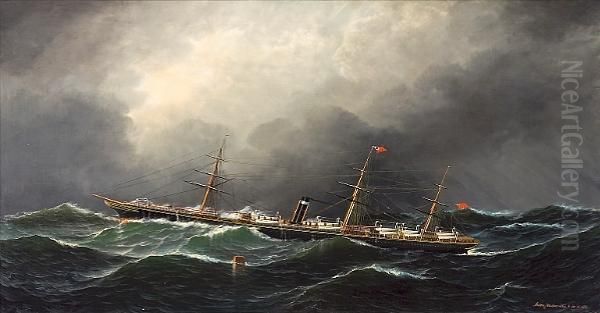
Antonio Jacobsen passed away on February 2, 1921, in West Hoboken, New Jersey, the town that had been his home and base of operations for nearly five decades. He left behind an unparalleled visual record of America's maritime heritage.
His legacy endures on multiple levels. For art collectors, his paintings remain popular, valued for their historical significance, decorative appeal, and connection to maritime history. Auction results for his works can range significantly depending on the subject, size, condition, and period, but well-regarded examples command substantial prices, confirming the snippet's observation of sales reaching tens of thousands of dollars.
For historians, Jacobsen's work is an indispensable resource. His commitment to accuracy provides detailed information about ship construction, shipping line identification, and the general appearance of ports and waterways during his lifetime. Museums with significant maritime collections, such as The Mariners' Museum and Park in Newport News, Virginia (which holds a very large collection of his work), the Peabody Essex Museum in Salem, Massachusetts, Mystic Seaport Museum in Connecticut, and the National Museum of American History, prominently feature his paintings.
Beyond the specialized worlds of art collecting and maritime history, Jacobsen's paintings offer a compelling glimpse into a dynamic era of American expansion, technological change, and global connection, all centered on the ships that were the vital arteries of commerce and travel.
Conclusion
Antonio Nicolo Gasparo Jacobsen was more than just a painter of ships; he was a dedicated visual historian. His move from Denmark to America placed him at the heart of one of the world's busiest ports during a period of profound transformation in maritime life. With remarkable diligence and skill, he captured the likenesses of thousands of vessels, creating a body of work impressive not only for its volume but also for its fidelity and historical value. From the elegant lines of the last great sailing ships to the imposing forms of early 20th-century steamers, Jacobsen's paintings serve as enduring portraits of the vessels that shaped an era. His title, "the Audubon of Steam Vessels," is well-earned, recognizing his unique contribution to both American art and maritime history.